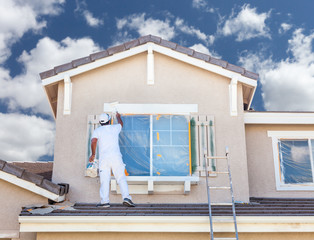The exterior of a home is the first thing people notice, and its appearance sets the tone for everything inside. A beautifully painted exterior not only improves curb appeal but also protects the home from harsh weather and natural wear. House exterior painting is one of the most effective ways to enhance a property’s look, extend its lifespan, and increase its value. Whether you’re planning to refresh an outdated color or give your home a brand-new style, exterior painting is a worthwhile investment.

The Importance of House Exterior Painting
House exterior painting is more than just a cosmetic upgrade. A properly painted home serves as a protective shield against the elements, such as sun, rain, wind, and fluctuating temperatures. Without a strong layer of paint, moisture and dirt can damage siding, trim, and other surfaces, leading to costly repairs.
Some of the main reasons homeowners prioritize exterior painting include:
- Improved Curb Appeal: A fresh coat of paint instantly enhances the look of a property.
- Protection from Weather: Quality paint acts as a barrier against water, UV rays, and mold.
- Increased Property Value: Well-maintained exteriors are more attractive to buyers.
- Extended Lifespan of Materials: Regular painting helps siding, wood, and trim last longer.
- Personal Expression: Exterior colors reflect personal taste and style.
When done correctly, house exterior painting provides both practical and aesthetic benefits.
Choosing the Right Paint Colors
Selecting the right color is one of the most exciting and challenging aspects of exterior painting. The right palette can make a home stand out or blend naturally with its surroundings. While preferences vary, there are key factors to consider:
- Architectural Style: Traditional homes may suit classic, neutral tones, while modern designs can shine with bold colors.
- Neighborhood Aesthetic: A harmonious look often comes from balancing individuality with community appeal.
- Climate Considerations: Lighter shades reflect heat in sunny climates, while darker hues can add warmth in cooler regions.
- Long-Term Maintenance: Neutral tones often remain timeless, while bold colors may require more frequent touch-ups.
The right choice ensures the home maintains both style and practicality.
Preparation Before House Exterior Painting
Preparation is the most critical step in achieving long-lasting results. Skipping this stage can lead to peeling, cracking, or uneven finishes. Proper preparation usually includes:
- Cleaning Surfaces: Pressure washing removes dirt, mildew, and old paint flakes.
- Repairing Damage: Any cracks, holes, or damaged siding should be fixed before painting.
- Sanding and Scraping: Smoothing out rough spots ensures even paint coverage.
- Priming: Applying primer improves adhesion and helps paint last longer.
- Protecting Surroundings: Covering windows, landscaping, and fixtures keeps them safe from drips and overspray.
These steps create a clean foundation for flawless application.
The Painting Process
The actual painting process requires precision, patience, and the right techniques. A smooth finish depends on proper layering and consistency. The process generally follows these steps:
- Priming: Ensures the paint bonds well to the surface.
- First Coat Application: Applied evenly using rollers or sprayers.
- Detail Work: Brushes are used for trim, edges, and intricate areas.
- Second Coat Application: Adds durability and enhances color vibrancy.
- Final Touches: Small adjustments and cleanups ensure a polished look.
Attention to detail at every stage makes the difference between a basic job and a professional finish.
Benefits of Professional House Exterior Painting
While some homeowners may consider painting their home themselves, hiring professionals often yields better results. Experienced painters bring expertise, efficiency, and the right tools to the job. The main advantages of professional painting include:
- Flawless Finish: Skilled painters deliver smooth, even coats without streaks.
- Time Savings: Professionals complete projects faster without compromising quality.
- Proper Equipment: Ladders, sprayers, and protective gear ensure efficiency and safety.
- Weather Resistance: High-quality techniques and products help paint withstand the elements.
- Long-Term Value: Professional work often lasts longer, reducing the frequency of repaints.
Investing in expert services ensures lasting beauty and protection for your home.
Current Trends in House Exterior Painting
Exterior painting styles continue to evolve with design trends and lifestyle preferences. Homeowners today are embracing:
- Earthy Neutrals: Warm grays, taupes, and beiges that complement natural surroundings.
- Bold Contrasts: Dark trims paired with light walls for dramatic effect.
- Two-Tone Designs: Using multiple colors to highlight architectural features.
- Eco-Friendly Options: Sustainable paints with low environmental impact.
- Matte Finishes: A modern alternative to glossy, reflective surfaces.
Staying updated with these trends ensures your home maintains a stylish and timeless look.
Maintenance After Painting
Once the painting project is complete, proper maintenance helps preserve the fresh appearance. Simple steps can extend the life of exterior paint:
- Regular Cleaning: Wash surfaces annually to remove dirt and prevent buildup.
- Inspecting for Damage: Check for peeling or cracks and address them early.
- Trimming Landscaping: Keep plants and trees from rubbing against painted surfaces.
- Touch-Ups: Quick fixes prevent small issues from becoming large repairs.
With care, a quality paint job can last several years, maintaining beauty and durability.
House exterior painting is one of the most effective ways to rejuvenate and protect your home. From enhancing curb appeal to safeguarding materials from weather damage, it offers both practical and aesthetic rewards. Choosing the right colors, preparing surfaces properly, and ensuring professional application are key to achieving long-lasting results.
With regular maintenance and an eye for design, house exterior painting transforms any property into a vibrant, welcoming space. More than just a coat of paint, it is an investment in the beauty, protection, and value of your home for years to come.